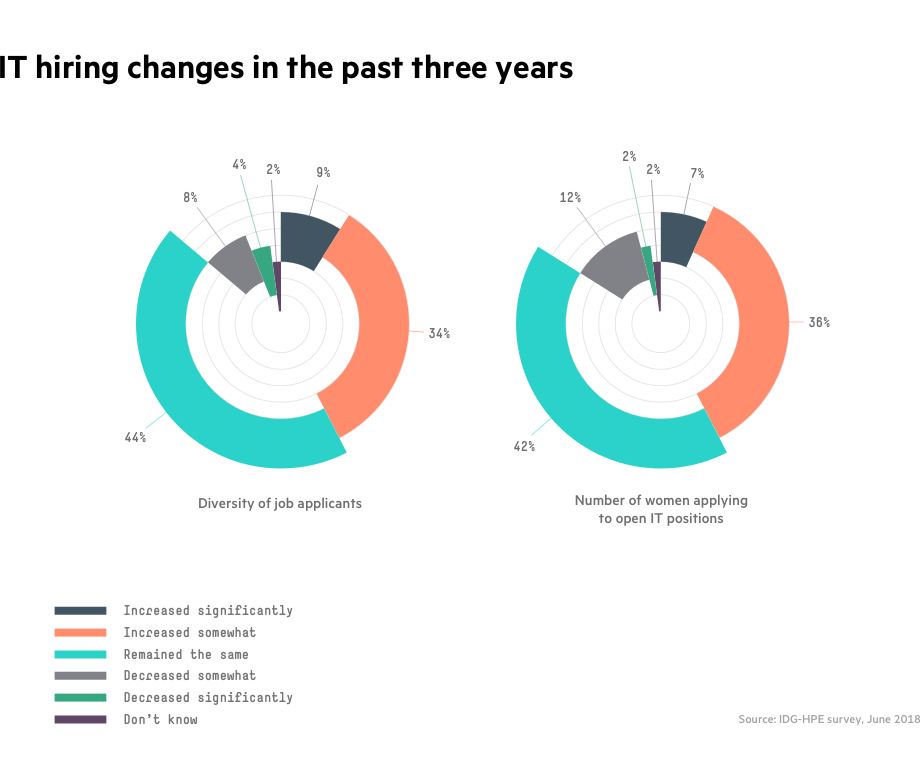Many companies have made efforts to attract women and minorities to IT positions, at every rung of the career ladder. New research suggests that workplace diversity programs are beginning to pay off: 43 percent of respondents report that the number of women applying to IT positions has increased over the past three years.
The tech industry and IT outposts have taken their knocks for being bastions of white male leadership and unruly “bro” culture, fueling concerns that the sector is unfriendly terrain for women and people of color. As a result, with renewed emphasis on the importance of diversity, companies launched new policies and practices to court nontraditional employees to the tech workplace.
Good news: They are making progress.
Diversity is a hot topic for business in general. However, alarms have been sounding in technology circles for the past few years because the industry is considered a laggard on this front. According to research from CompTIA, a tech industry association, 45 percent of companies surveyed believe the industry’s progress on diversity doesn’t measure up to efforts.

That position is supported by a U.S. Equal Employment Opportunity Commission (EEOC) report that describes the high-tech workforce as “overwhelmingly white and male” and with far less representation from African Americans, women, and Hispanics compared with non-tech sectors. Specifically, the report says men occupy 80 percent of executive roles compared with 20 percent for women. In the private sector overall, men hold 71 percent of leadership positions, while women account for 29 percent of those roles.
And that’s not the only thing of note: The Center for Talent Innovation found that women working in the tech field leave their jobs at a much higher rate (45 percent) than their male counterparts, primarily due to cultural issues, the omnipresent inequitable pay scale, and lack of inclusion. When you find yourself the sole female on a DevOps team or at a job site, it’s easy to feel isolated or cut off from the banter and an informal buddy network. Women also said expectations to conform to biased standards of leadership set forth by company executives are also a hurdle.
The struggle for greater diversity in the workplace isn’t just a feel-good HR talking point. Studies show both gender and ethnic diversity are key to successful businesses. Sixty-four percent of respondents to the CompTIA survey agree that a more diverse technology organization is more likely to produce world-class innovation compared with one with a homogeneous makeup.
Diversity policy 101
There are strong signs that the diversity message is finally resonating. Companies, large and small, have a variety of efforts underway to promote greater diversity in the IT workplace. High-tech behemoths including Apple, Hewlett Packard Enterprise, Microsoft, and Google have installed chief diversity and inclusion officers and released their diversity numbers. Others, like Salesforce, have pledged to close the gender pay gap.
Even smaller companies are getting in on the action, changing where they fish for new hires, modifying interview tactics to be less intimidating and male-dominated, implementing inclusion programs, and working with HR to institute new family-friendly and flexible work policies.
Beyond sweeping policy changes, small tweaks to company practices can also make a big difference in cultivating diversity. Creating family-friendly workspaces (with pumping rooms, for example), making female and ethnically diverse staffers a prominent part of the interview process, and pressing for policies that promote work-life balance are instrumental for extending the net to capture the widest array of applicant types.
In that vein, 34 percent of 101 senior IT managers polled in a June 2018 IDG-HPE survey say they offer telecommuting options as a way to attract new talent. What’s more, female IT managers favor layering on perks such as telecommuting options to improve a package when a good candidate declines the first job offer (21 percent compared with 7 percent of male managers), according to the survey.
These corporate efforts are starting to pay off, the IDG-HPE survey found. Thirty-six percent of survey respondents say they are making strides toward creating an age-diverse culture. At the same time, 43 percent report that the number of women applying to IT positions has increased over the past three years—and 7 percent characterize the increase as significant. In the largest companies, with more than 10,000 employees, 53 percent see an increase in the diversity of job applicants. Those in younger age groups are more likely to perceive an impact from these new diversity practices, which may be an indication that they are more invested in improving the numbers.
The bottom line
Diversity—whether by age, sex, or ethnicity—is an increasingly important attribute of a successful and innovative IT workplace. By changing up the work environment and embracing new practices to attract a more varied job applicant pool, organizations achieve a win-win: They help bridge the troublesome IT talent gap while finally putting to rest the long-standing perception of IT as a boys’ club.
Destination url: https://www.hpe.com/us/en/insights/articles/good-news-for-it-diversity-efforts-1810.html?jumpid=in_510397410_NXTgoodnewsdiversity1016&jumpid=_TWITTER_








